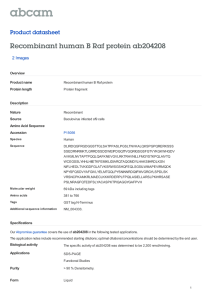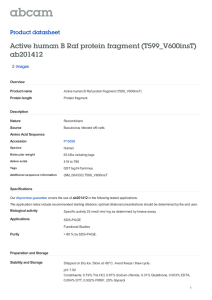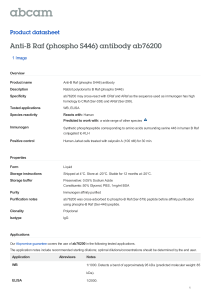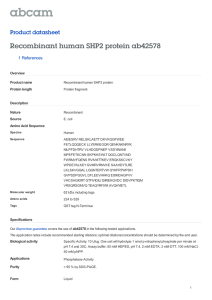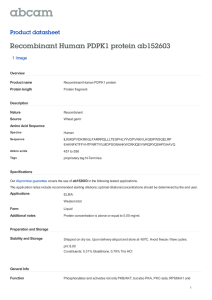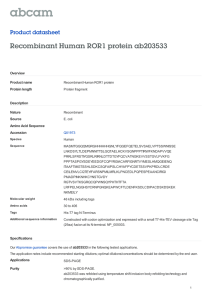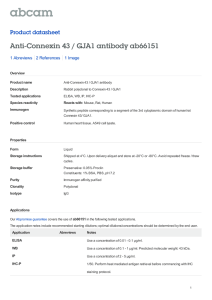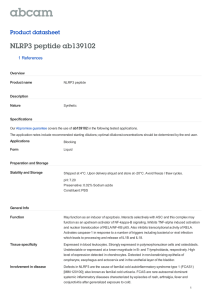Recombinant human B Raf protein ab204212 Product datasheet 2 Images Overview
advertisement
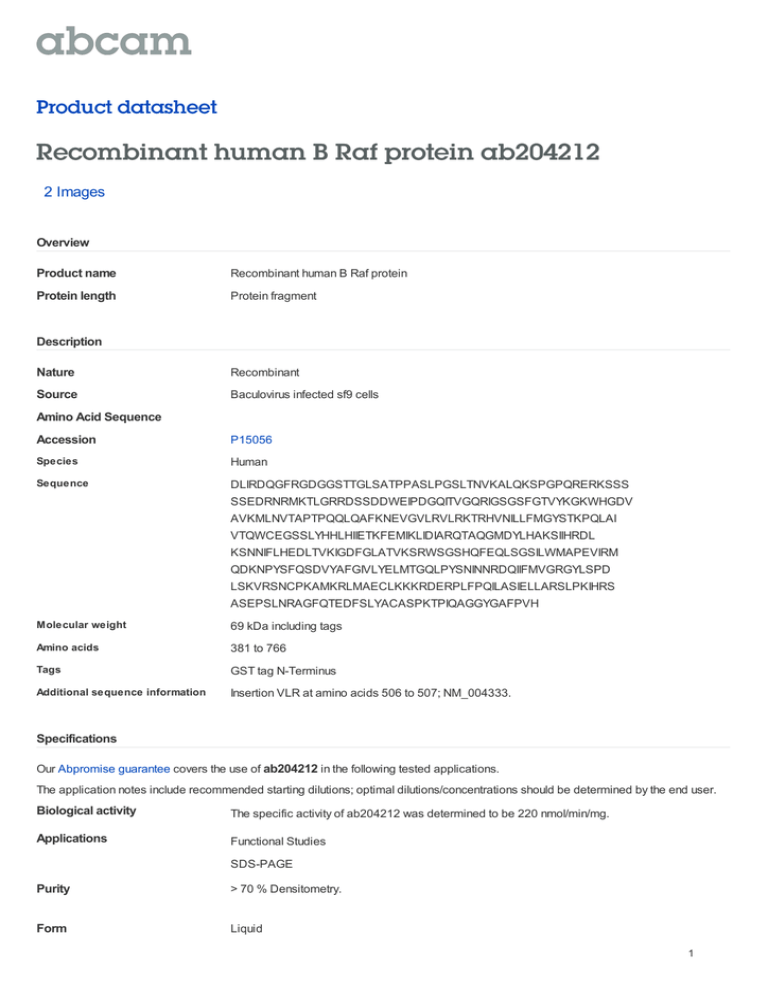
Product datasheet Recombinant human B Raf protein ab204212 2 Images Overview Product name Recombinant human B Raf protein Protein length Protein fragment Description Nature Recombinant Source Baculovirus infected sf9 cells Amino Acid Sequence Accession P15056 Species Human Sequence DLIRDQGFRGDGGSTTGLSATPPASLPGSLTNVKALQKSPGPQRERKSSS SSEDRNRMKTLGRRDSSDDWEIPDGQITVGQRIGSGSFGTVYKGKWHGDV AVKMLNVTAPTPQQLQAFKNEVGVLRVLRKTRHVNILLFMGYSTKPQLAI VTQWCEGSSLYHHLHIIETKFEMIKLIDIARQTAQGMDYLHAKSIIHRDL KSNNIFLHEDLTVKIGDFGLATVKSRWSGSHQFEQLSGSILWMAPEVIRM QDKNPYSFQSDVYAFGIVLYELMTGQLPYSNINNRDQIIFMVGRGYLSPD LSKVRSNCPKAMKRLMAECLKKKRDERPLFPQILASIELLARSLPKIHRS ASEPSLNRAGFQTEDFSLYACASPKTPIQAGGYGAFPVH Molecular weight 69 kDa including tags Amino acids 381 to 766 Tags GST tag N-Terminus Additional sequence information Insertion VLR at amino acids 506 to 507; NM_004333. Specifications Our Abpromise guarantee covers the use of ab204212 in the following tested applications. The application notes include recommended starting dilutions; optimal dilutions/concentrations should be determined by the end user. Biological activity The specific activity of ab204212 was determined to be 220 nmol/min/mg. Applications Functional Studies SDS-PAGE Purity > 70 % Densitometry. Form Liquid 1 Preparation and Storage Stability and Storage Shipped on Dry Ice. Upon delivery aliquot. Store at -80°C. Avoid freeze / thaw cycle. pH: 7.5 Constituents: 0.79% Tris HCl, 0.87% Sodium chloride, 0.31% Glutathione, 0.003% EDTA, 0.004% DTT, 0.002% PMSF, 25% Glycerol This product is an active protein and may elicit a biological response in vivo, handle with caution. General Info Function Involved in the transduction of mitogenic signals from the cell membrane to the nucleus. May play a role in the postsynaptic responses of hippocampal neuron. Tissue specificity Brain and testis. Involvement in disease Note=Defects in BRAF are found in a wide range of cancers. Defects in BRAF may be a cause of colorectal cancer (CRC) [MIM:114500]. Defects in BRAF are involved in lung cancer (LNCR) [MIM:211980]. Defects in BRAF are involved in non-Hodgkin lymphoma (NHL) [MIM:605027]. NHL is a cancer that starts in cells of the lymph system, which is part of the body's immune system. NHLs can occur at any age and are often marked by enlarged lymph nodes, fever and weight loss. Defects in BRAF are a cause of cardiofaciocutaneous syndrome (CFC syndrome) [MIM:115150]; also known as cardio-facio-cutaneous syndrome. CFC syndrome is characterized by a distinctive facial appearance, heart defects and mental retardation. Heart defects include pulmonic stenosis, atrial septal defects and hypertrophic cardiomyopathy. Some affected individuals present with ectodermal abnormalities such as sparse, friable hair, hyperkeratotic skin lesions and a generalized ichthyosis-like condition. Typical facial features are similar to Noonan syndrome. They include high forehead with bitemporal constriction, hypoplastic supraorbital ridges, downslanting palpebral fissures, a depressed nasal bridge, and posteriorly angulated ears with prominent helices. The inheritance of CFC syndrome is autosomal dominant. Defects in BRAF are the cause of Noonan syndrome type 7 (NS7) [MIM:613706]. Noonan syndrome is a disorder characterized by facial dysmorphic features such as hypertelorism, a downward eyeslant and low-set posteriorly rotated ears. Other features can include short stature, a short neck with webbing or redundancy of skin, cardiac anomalies, deafness, motor delay and variable intellectual deficits. Defects in BRAF are the cause of LEOPARD syndrome type 3 (LEOPARD3) [MIM:613707]. LEOPARD3 is a disorder characterized by lentigines, electrocardiographic conduction abnormalities, ocular hypertelorism, pulmonic stenosis, abnormalities of genitalia, retardation of growth, and sensorineural deafness. Note=A chromosomal aberration involving BRAF is found in pilocytic astrocytomas. A tandem duplication of 2 Mb at 7q34 leads to the expression of a KIAA1549-BRAF fusion protein with a constitutive kinase activity and inducing cell transformation. Sequence similarities Belongs to the protein kinase superfamily. TKL Ser/Thr protein kinase family. RAF subfamily. Contains 1 phorbol-ester/DAG-type zinc finger. Contains 1 protein kinase domain. Contains 1 RBD (Ras-binding) domain. Cellular localization Nucleus. Cytoplasm. Cell membrane. Colocalizes with RGS14 and RAF1 in both the cytoplasm and membranes. Recombinant human B Raf protein images 2 The purity of ab204212 was determined to be >70% by densitometry. Approximate MWt: 69 kDa. SDS-PAGE - Active human B Raf protein fragment (ab204212) Kinase assay showing the specific activity of ab204212 as 220 nmol/min/mg. Functional Studies - Active human B Raf protein fragment (ab204212) Please note: All products are "FOR RESEARCH USE ONLY AND ARE NOT INTENDED FOR DIAGNOSTIC OR THERAPEUTIC USE" Our Abpromise to you: Quality guaranteed and expert technical support Replacement or refund for products not performing as stated on the datasheet Valid for 12 months from date of delivery Response to your inquiry within 24 hours We provide support in Chinese, English, French, German, Japanese and Spanish Extensive multi-media technical resources to help you We investigate all quality concerns to ensure our products perform to the highest standards If the product does not perform as described on this datasheet, we will offer a refund or replacement. For full details of the Abpromise, please visit http://www.abcam.com/abpromise or contact our technical team. Terms and conditions Guarantee only valid for products bought direct from Abcam or one of our authorized distributors 3
